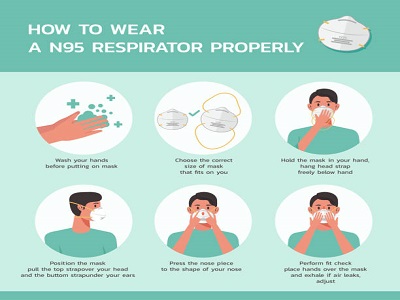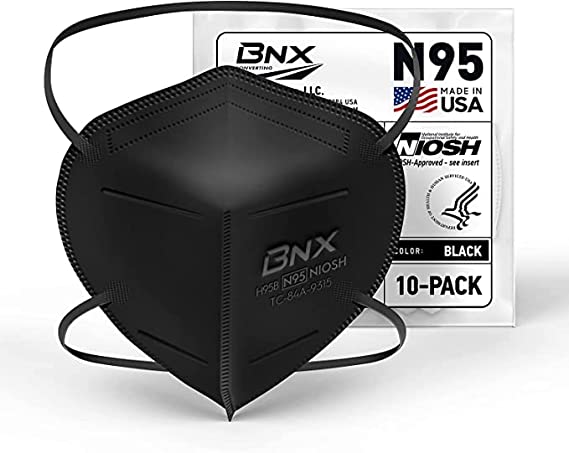An N95 filtering face piece respirator, commonly abbreviated N95 respirator, is a particulate-filtering face piece respirator that meets the U.S. National Institute for Occupational Safety and Health (NIOSH) N95 classification of air filtration, meaning that it filters at least 95% of airborne particles. The standard does not specify that the respirator must be resistant to oils. However, another standard, P95 adds this requirement. The N95 type is the most common particulate-filtering face piece respirator. It is an example of a mechanical filter respirator, which provides protection against particulates but not against gases or vapors. An authentic N95 respirator is marked with the text “NIOSH” or the NIOSH logo, the filter class (“N95”), a “TC” approval number of the form XXX-XXXX, the approval number must be listed on the NIOSH Certified Equipment List (CEL) or the NIOSH Trusted-Source page, and it must have headbands instead of ear loops.
Only use N95 mask that have been certified by the National Institute for Occupational Safety and Health. On the packaging or mask, look for the NIOSH logo. Masks not certified by NIOSH might not offer adequate protection. You can usually find masks at your local hardware store or home improvement center. Even if the particles are too small to see, you can still use an N95 mask.
Wearing a mask is a critical way to prevent the spread of COVID-19. Masks and respirators, when worn consistently and correctly, are effective at reducing the transmission of SARS-CoV-2, the virus that causes COVID-19.
How Efficient Are N95 Mask?
N95 mask have been approved by NIOSH (National Institute for Occupational Safety and Health). They are at least 95% effective in filtering out virus-sized particles. The mask should fit tightly over your nose and mouth. It should also not have any gaps around the nose or edges.
Medical experts say that wearing an N95 mask will help you clean the air better if you are in a crowded area with people who may have COVID infections. N95 masks prevent particles and droplets from entering the airways through your nose, cough, or sneeze.
Also, KN95 masks and N95 masks fall under the respirator category. They are tested and designed to conform to international standards. According to some unverified reports, KN95 masks are less protective than NIOSH-approved N95 masks but still offer more protection than cloth masks.
Health professionals recommend that people caring for someone with COVID-19, such as older adults or people at greater risk of complications from a corona virus infection, wear a respirator mask. People who regularly interact with the public, such as bus drivers and grocery clerks, should also wear respirator masks. You can take public transport or hop on a cross-country plane. It’s a great time to use an N95 or similar.
How to wear the N95 mask

Follow the manufacturer’s instructions when wearing an N95 mask.The mask must cover the mouth and nose to prevent you from inhaling mold and dust. It will not function properly if it is not snugly fitted. The mask must be properly fitted to your skin. People with facial hair or beards will find it difficult to use. Air can leak even from a single day of beard growth. To prevent air from leaking around the mask, make sure you use both straps.
Following are the tips to make sure that the N95 masks fits properly:
To ensure that the mask fits correctly, do a user seal test, which includes both positive and negative pressure tests.

Negative pressure check
Inhale deeply and place your hands over the mask. You must be careful not to move the mask. The mask should fit snugly into your face. If you feel that there is the air around your eyes or face, adjust the nose piece and straps.
Positive pressure check
Place your hands on the mask and exhale quickly. If your mask has an expiration valve, such as the one shown above, make sure you cover it when exhaling. If the mask fits correctly, there should be no air leakage. If the mask leaks, adjust the nose piece and straps again and perform the negative pressure test.
When to throw out the N95 mask
It becomes harder to breathe when the N95 mask is clogged. Throw it out and get a new one. If the mask is dirty or wet on the inside, deformed, or has a damaged filter, throw it out. An inelastic mask might not fit correctly. An N95 mask can’t be washed or disinfected.
